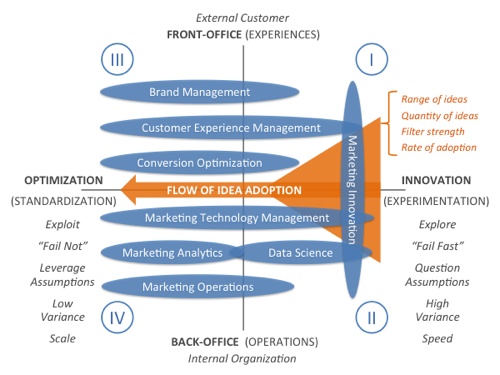
Having spent many years in the “conversion optimization” subdiscipline of marketing—a forerunner to what is now known as “growth hacking” in some circles—I’ve mulled over the inherent tension between innovation and optimization for a while.
They’re two different mindsets.
At its best, innovation is about exploring a wide range of bold, new ideas that challenge the status quo—often questioning assumptions that an organization takes for granted. Many of these daring experiments don’t work out, but that’s okay, as long as they “fail fast.” You’re panning for gold, which means sifting through a lot of dirt.
On the other end of the spectrum, optimization is about refining a raw idea—making it more effective and efficient. You’re exploiting a previously discovered innovation. You’re leveraging assumptions about an idea to scale it up, to standardize its execution across your organization. You’re turning those gold nuggets into priceless jewelry.
While I am reluctant to play into oversimplified stereotypes, innovation tends to be more intuitive (“right brain”) and optimization more analytical (“left brain”). Some people are instinctively gold prospectors, while others are master jewelers. But many marketers are ambidextrous and capable of both—although not necessarily at the same time. My experience has been that a marketing team is typically in one mode or the other, largely depending on organizational context.
Both are important to a healthy and sustainable business. Optimization without innovation is myopia. Innovation without optimization is the organizational equivalent of ADHD.
As a marketing leader, you want to structure your department to have both. They can—and must—coexist. But each end of the spectrum benefits from different kinds of management approaches and incentives. You will likely want different captains on each side.
There’s another two-ended spectrum in marketing: front-end experiences and back-office operations. Marketing used to be mostly concerned with customer-facing communications. But as the scope of marketing has expanded into “experiences” along the buyer’s journey, the importance of software and data in marketing has grown significantly—as have the roles of marketing operations, marketing analytics and marketing technology management to support these new capabilities.
Both ends of this spectrum are important: You need champions of customer experience and defenders of the brand. But you also need operational strength to realize those visions. And as with innovation and optimization, there are often different dynamics in managing front-office experiences vs. back-office operations. The captain of customer experience is likely quite different than the captain of marketing operations.
You can innovate customer experiences and optimize them. You can innovate internal operations and optimize it.
Which led me to visualize the 4 quadrants of marketing management as a 2×2 model.
It provides a framework by which we can distinguish between these different facets of marketing. We can ask questions such as:
- Which quadrants are we good at?
- Which quadrants do we need to improve?
- Who leads each quadrant and with what incentives?
- What processes do we have to facilitate collaboration between quadrants?
- What is our rate of flow of new ideas from innovation to optimization?

To make this model a little more concrete, I mapped some common marketing subdisciplines into these quadrants—many cover a continuum across two or more — such as customer experience management, conversion optimization, marketing technology management, data science, etc. These aren’t intended as iron-clad definitions, so much as centers of gravity, at least as I’ve observed them.
For instance, marketing technology management is a back-office function, but it tends to interface to more front-end customer experience work than, say, traditional marketing operations. It also tends to span innovation and optimization programs as an enabler for both.
I’m still thinking through this model, so I’d appreciate any feedback you’d like to offer.
Do you find this a helpful way to frame marketing management in your company?
This content originally appeared on the Chief Marketing Technologist Blog by Scott Brinker. For more information, visit chiefmartec.com.









